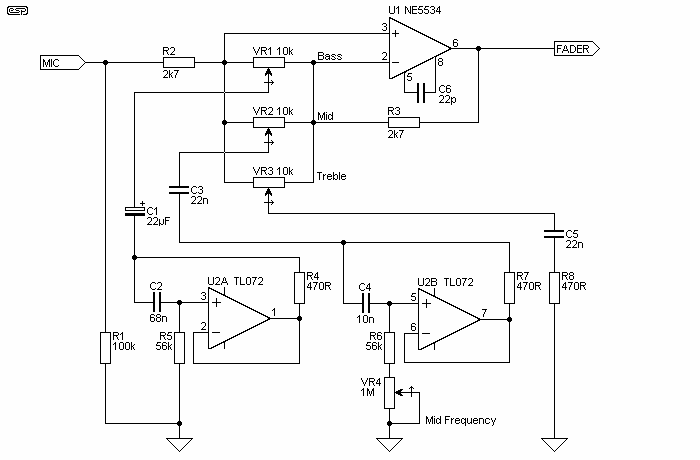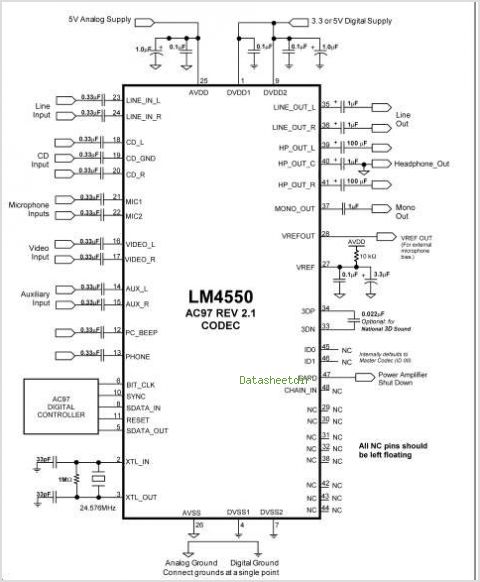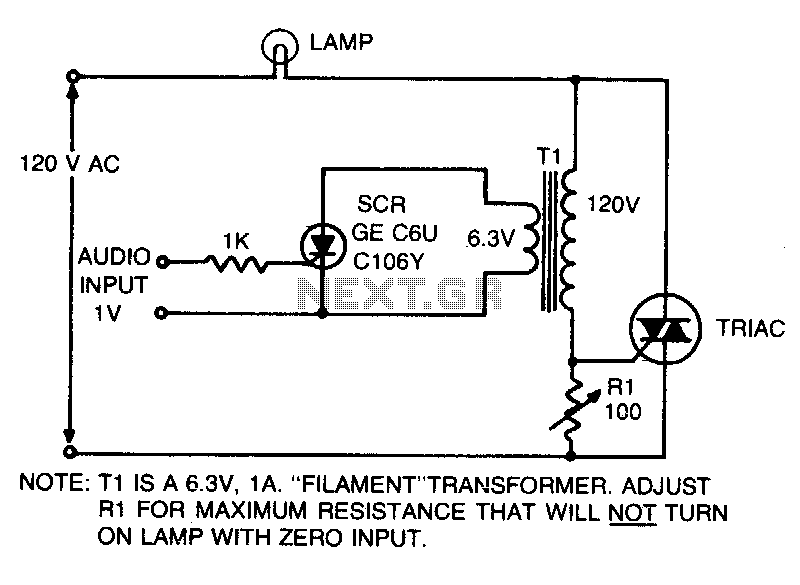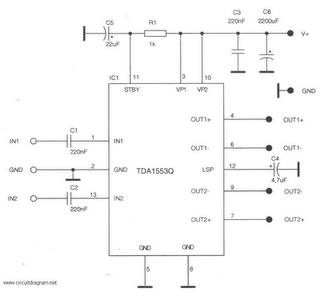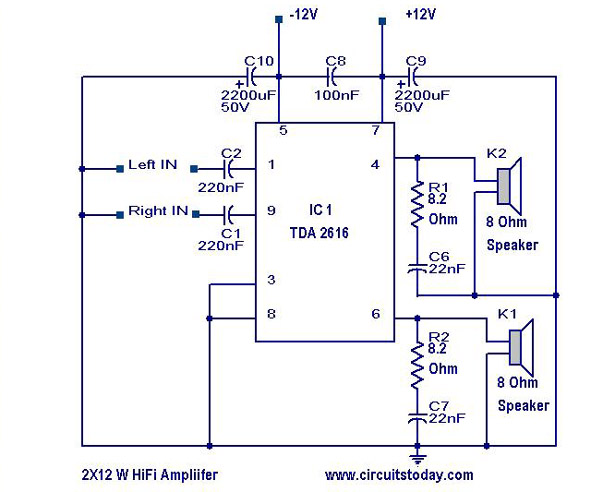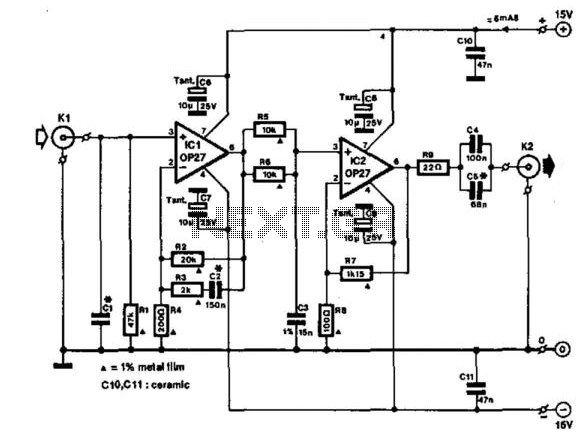
PC audio amplifier 12Watt
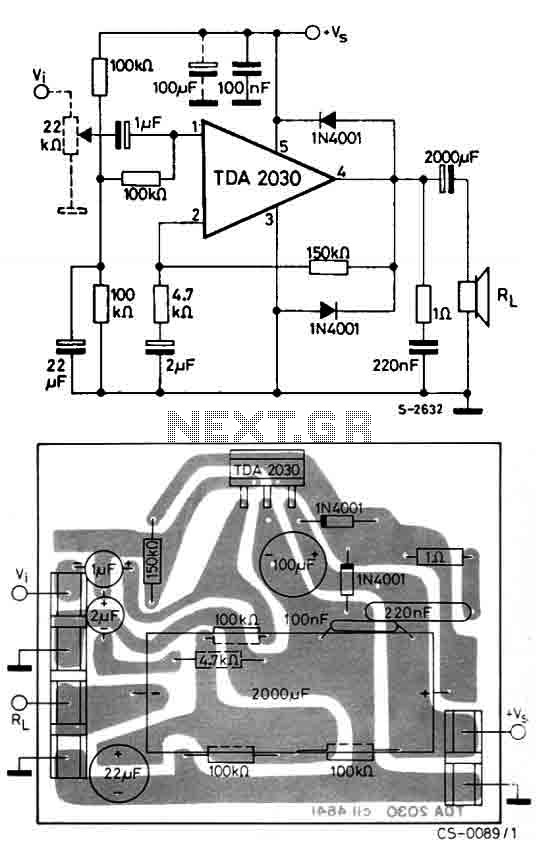
The circuit utilizes the TDA2030, a monolithic integrated circuit housed in a Pentawatt package, designed for use as a low-frequency class AB amplifier. It typically delivers 14W of output power (with a distortion factor of 0.5%) at 14V with a 4-ohm load. When powered with ±14V or 28V, the guaranteed output power is 12W for a 4-ohm load and 8W for an 8-ohm load, according to DIN45500 standards. The TDA2030 is capable of providing high output current while maintaining very low harmonic and crossover distortion.
Additionally, the device features a unique (and patented) short circuit protection system that includes a mechanism for automatically limiting dissipated power, ensuring that the output transistors operate within their safe limits. A conventional thermal shutdown system is also integrated into the design.
The TDA2030 is a versatile low-frequency amplifier well-suited for various audio applications. It operates effectively in both consumer and professional audio systems, providing a robust solution for driving speakers. The device's ability to deliver substantial power while minimizing distortion makes it ideal for high-fidelity sound reproduction.
In terms of circuit design, the TDA2030 requires a few external components for optimal performance. A suitable power supply should provide the necessary voltage levels, typically ±14V to ±28V, depending on the desired output power. Bypass capacitors are recommended to stabilize the supply voltage and reduce noise. Additionally, feedback resistors can be employed to set the gain of the amplifier, allowing for customization based on the application requirements.
The short circuit protection system is critical for preventing damage to the amplifier under fault conditions. It operates by monitoring the output current and adjusting the power dissipation accordingly. This feature ensures reliable operation and longevity of the amplifier in various environments.
Thermal management is also essential when implementing the TDA2030 in a circuit. The thermal shutdown feature activates when the junction temperature exceeds safe limits, temporarily disabling the amplifier until it cools down. Proper heatsinking is recommended to dissipate heat efficiently, particularly in high-power applications.
Overall, the TDA2030 is a robust choice for audio amplification, offering a combination of power, efficiency, and protection features that enhance its reliability and performance in diverse applications.The circuit uses the TDA2030 which is a monolithic integrated circuit in Pentawatt® package, intended for use as a low frequency class AB amplifier. Typically it provides 14W output power (d = 0.5%) at 14V/4Ω; at ± 14V or 28V, the guaranteed output power is 12W on a 4Ω load and 8W on a 8Ω (DIN45500).
The TDA2030 provides high output current and has very low harmonic and cross-over distortion. Further the device incorporates an original (and patented) short circuit protection system comprising an arrangement for automatically limiting the dissipated power so as to keep the working point of the output transistors within their safe operating area. A conventional thermal shut-down system is also included. 🔗 External reference
Additionally, the device features a unique (and patented) short circuit protection system that includes a mechanism for automatically limiting dissipated power, ensuring that the output transistors operate within their safe limits. A conventional thermal shutdown system is also integrated into the design.
The TDA2030 is a versatile low-frequency amplifier well-suited for various audio applications. It operates effectively in both consumer and professional audio systems, providing a robust solution for driving speakers. The device's ability to deliver substantial power while minimizing distortion makes it ideal for high-fidelity sound reproduction.
In terms of circuit design, the TDA2030 requires a few external components for optimal performance. A suitable power supply should provide the necessary voltage levels, typically ±14V to ±28V, depending on the desired output power. Bypass capacitors are recommended to stabilize the supply voltage and reduce noise. Additionally, feedback resistors can be employed to set the gain of the amplifier, allowing for customization based on the application requirements.
The short circuit protection system is critical for preventing damage to the amplifier under fault conditions. It operates by monitoring the output current and adjusting the power dissipation accordingly. This feature ensures reliable operation and longevity of the amplifier in various environments.
Thermal management is also essential when implementing the TDA2030 in a circuit. The thermal shutdown feature activates when the junction temperature exceeds safe limits, temporarily disabling the amplifier until it cools down. Proper heatsinking is recommended to dissipate heat efficiently, particularly in high-power applications.
Overall, the TDA2030 is a robust choice for audio amplification, offering a combination of power, efficiency, and protection features that enhance its reliability and performance in diverse applications.The circuit uses the TDA2030 which is a monolithic integrated circuit in Pentawatt® package, intended for use as a low frequency class AB amplifier. Typically it provides 14W output power (d = 0.5%) at 14V/4Ω; at ± 14V or 28V, the guaranteed output power is 12W on a 4Ω load and 8W on a 8Ω (DIN45500).
The TDA2030 provides high output current and has very low harmonic and cross-over distortion. Further the device incorporates an original (and patented) short circuit protection system comprising an arrangement for automatically limiting the dissipated power so as to keep the working point of the output transistors within their safe operating area. A conventional thermal shut-down system is also included. 🔗 External reference
